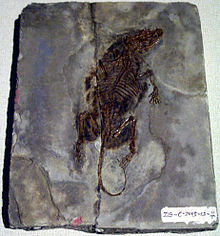Zhangheotherium
| Zhangheotherium | |
|---|---|

| |
| Fossil specimen, Hong Kong Science Museum | |
| Scientific classification | |
| Domain: | Eukaryota |
| Kingdom: | Animalia |
| Phylum: | Chordata |
| Class: | Mammalia |
| Order: | †Symmetrodonta |
| Family: | †Zhangheotheriidae |
| Genus: | †Zhangheotherium Hu, Y.Q. Wang, Luo & C.K. Li, 1997 |
| Type species | |
| †Zhangheotherium quinquecuspidens Hu, Wang, Luo & Li, 1997
| |
Zhangheotherium is an extinct
symmetrodont" mammal from the Early Cretaceous of China. A single species is known, Zhangheotherium quinquecuspidens from Jianshangou Beds of the Yixian Formation. Zhangheotherium was the first "symmetrodont" known from a nearly complete skeleton, expanding knowledge of the group beyond isolated teeth and jaws. The genus name honors Zhang He, who collected the holotype fossil from Liaoning Province prior to its 1997 description. The specific name is Latin for "five-cusped teeth".[1]
"Symmetrodonts" and other archaic mammals such as
stem-group therians, with representatives incrementally closer to true therians than to monotremes.[1]
Description
manubrium (upper component of the sternum or breastbone). Monotremes possess a large hourglass-shaped interclavicle while in therians the bone shrinks and fuses with the manubrium during embryonic development. In Zhangheotherium, the clavicles have flexible connections to their neighboring bones, allowing for a greater potential for movement in the scapula (shoulder blade). On the other hand, the humerus (upper arm bone) is more reptilian in form, with a small greater tubercle and underdeveloped trochlea.[1] As a result, Zhangheotherium probably walked in a sprawling manner,[1] like monotremes and some other Early Cretaceous mammals such as Jeholodens and Repenomamus
.
Like other "symmetrodonts", each
talonid "heel" of true therian molars.[1]
Paleoecology

Zhangheotherium is one of several extinct mammals reported to bear a spur-like bone in the ankle. This may have had
scansorial lifestyle, possessing long hindlimbs and a large plantar area on the foot, both optimal for climbing.[3] Specimen GMV 2124 of the feathered dinosaur Sinosauropteryx? sp. contained two jaws of Zhangheotherium in its stomach region. Thus, it seems to have preyed on this primitive mammal, possibly on a regular basis.[2]
References
- ^ ISSN 1476-4687.
- ^ a b Hurum, Jørn H.; Luo, Zhe-Xi; Kielan-Jaworowska, Zofia (2006). "Were mammals originally venomous?" (PDF). Acta Palaeontologica Polonica. 51 (1): 1–11.
- ISSN 0094-8373.
